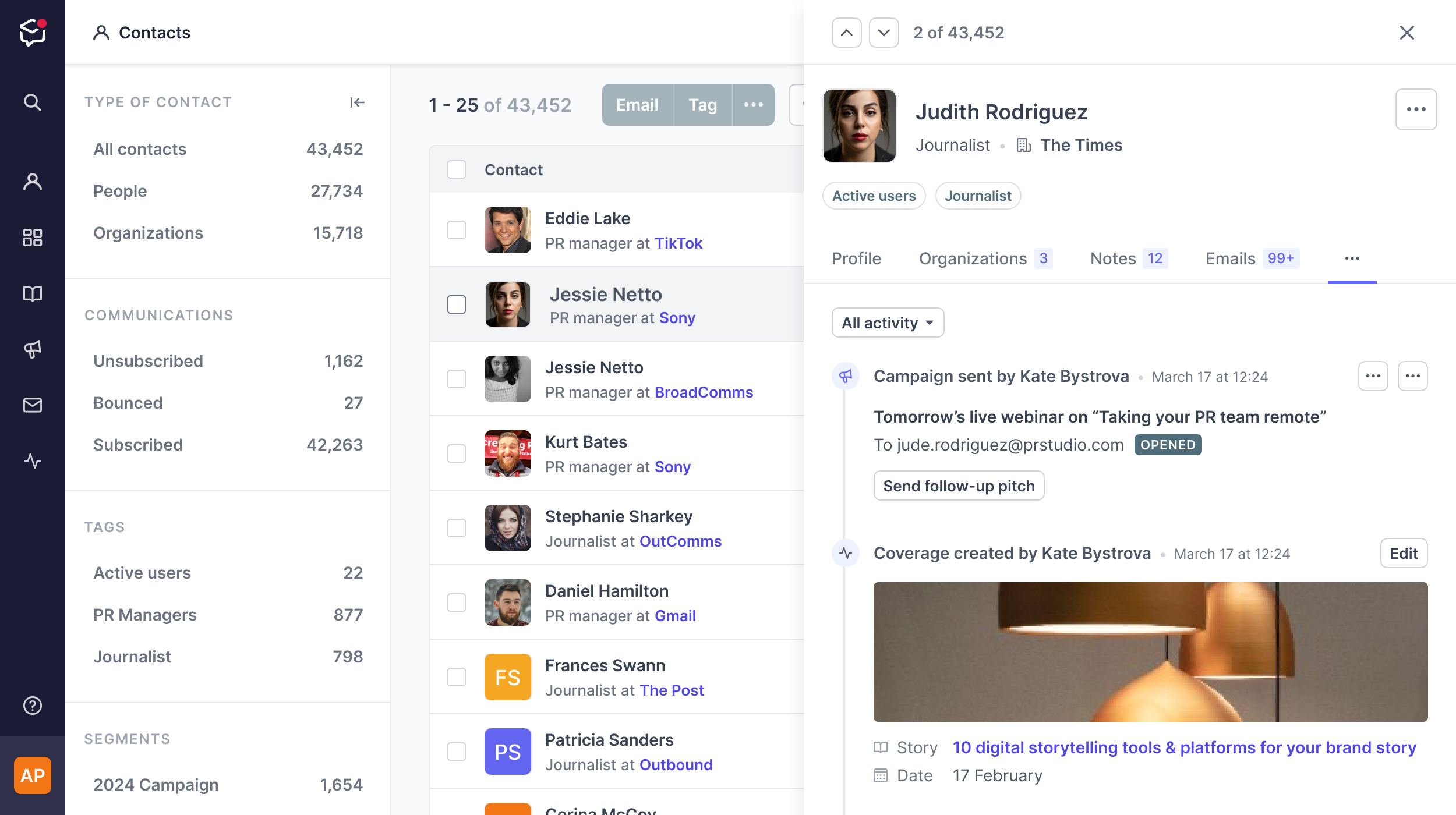PR 101: An Actionable Guide to Public Relations (in 2025)
An introduction to PR strategy, tactics, and measurement.
Whether you’re a new business trying to get noticed or a seasoned brand looking to stay relevant, PR is essential for building trust and making meaningful connections. It’s the tool that helps you shape how the world sees you.
But PR isn’t just about shouting your message – it’s about creating genuine relationships, managing perceptions, and putting out fires before they have time to engulf a brand's whole reputation. It’s about crafting a story that resonates with your audience and builds trust over time.
In this “public relations 101” guide, we’ll go over the basics of PR, share actionable tactics, and introduce you to tools like Prezly that will make your PR journey smoother.
Prezly – software for modern PR teams
Write & publish brand stories in an online newsroom
Send email campaigns, pitches & newsletters
Manage all your contacts in a single CRM, with easy import & export
Measure performance with analytics & built-in media monitoring

Think of PR as a bridge between your organization and the public. It’s not just about getting your name in the press – it’s about ensuring your message aligns with your values, resonates with your audience, and enhances your reputation. Effective public relations efforts involve aligning PR metrics with business goals to demonstrate ROI.
At its core, PR is about managing your reputation and the way your audience perceives you. It’s the art of crafting your brand’s message, building trust, and fostering meaningful relationships.
Whether you’re launching a product, responding to a crisis, or engaging with your community, PR plays a pivotal role in how people view your brand.
When it comes to PR implementation, you have two main options:
- In-house PR teams: These are part of your organization and focus solely on your brand’s needs and goals. They offer specialist knowledge of your business and can provide highly tailored solutions
- PR agencies: External experts who can bring a broader perspective, extensive connections, and specialized expertise. PR firms can often navigate large-scale campaigns or complex challenges with ease
Both approaches have their perks. An in-house team offers a personal touch and deep brand familiarity, while agencies bring external insight and the ability to scale efforts across industries.
The right choice depends on your particular needs, resources, and goals. (More on that below.)
The field of public relations has been shaped by several key figures, often referred to as the forefathers of the PR industry. Edward Bernays, known as the father of public relations, defined PR as the practice of advising clients on social attitudes and actions to appeal to the public. Harold Burson, cofounder of Burson-Marsteller, described PR as “doing good and getting credit for it”.
Other notable pioneers include Daniel Edelman, Al Golin, and David Finn, who each contributed to establishing and evolving the PR industry. Their work laid the foundation for modern public relations practices, emphasizing the importance of strategic communication and ethical conduct.
More recently, big names in PR have included Gini Dietrich, Richard Bagnall, Stephen Waddington and others. The list is always evolving. To stay in the loop, join online PR communities and take part in the conversations.
Public relations is essential for businesses to manage how their brand is perceived by the public and stakeholders. Effective PR techniques involve connecting with the right audience through a powerful media-based public relations strategy.
A well-developed PR strategy can bring huge benefits to organizations, including increased brand awareness and credibility. By strategically guiding public perception, businesses can build trust, foster loyalty, and achieve long-term success.
Social is now embedded in it fully and wholly. Most important: every piece of the new social media press release must be independently shareable.

A good PR plan can bring numerous benefits to a business, including increased brand awareness and credibility. A strong public relations strategy should help a company to:
- Build a positive image
- Increase brand awareness
- Establish credibility
- Manage reputation
- Engage with stakeholders
By leveraging a strong public relations strategy, businesses can effectively communicate their values, connect with their audience, and navigate the complexities of public perception.
Public relations is a flexible term that covers a wide range of activities, from managing a company’s reputation to engaging with stakeholders and the community. It certainly isn’t a one-size-fits-all solution.
Depending on your goals – whether it’s boosting your profile in a crowded market, handling a tough situation, or making meaningful community connections – the approach can vary significantly.
Using various media channels is crucial in PR strategies to connect specific topics with the right audiences through different forms of media.
Let’s dig deeper into the different types of PR to find what best fits your needs.

Media relations focuses on PR professionals building relationships with journalists and securing press coverage. It’s about getting your story into trusted publications or news outlets to reach a wider audience.
For example: Pitching a story about your new app to a tech blog or securing a feature in a lifestyle magazine. Utilizing PR tools can help in monitoring media coverage and evaluating the success of these efforts.
Why it matters: Journalists act as trusted gatekeepers, amplifying your story and adding credibility to your brand. A mention in a respected publication such as The New York Times can significantly boost your visibility and trustworthiness
Crisis communications help you manage your response during challenging situations to protect your reputation. Whether it’s a PR crisis stemming from a product recall, a public misstep, or negative media coverage, having a clear and transparent communication strategy is critical.
For example: Issuing a timely statement addressing a data breach or hosting a press conference to clarify misunderstandings.
The goal: Reassure stakeholders, maintain transparency, and minimize negative impact.
This type of PR ensures employees are informed, engaged, and aligned with company goals. Internal PR fosters a positive workplace culture, encourages loyalty, and transforms employees into brand advocates.
For example: Sending regular newsletters, hosting Q&A sessions with leadership, or organizing team-building events.
Why it matters: Happy, informed employees can become strong ambassadors for your brand, sharing its values and mission organically.

Influencer partnerships leverage the reach of social media personalities to promote your brand. This type of PR is particularly effective in connecting with younger, digitally savvy audiences.
For example: Collaborating with a fitness influencer to showcase your new activewear line or sponsoring a popular TikTokker’s content.
Why it works: Influencers have built trust with their audiences, making their endorsements feel more authentic and relatable.
Community relations focus on building goodwill and fostering strong local relationships. It’s about showing your brand cares about its community and making a tangible impact.
Examples: Organizing neighborhood clean-ups, sponsoring local sports teams, or donating to local charities.
Why it’s important: A positive reputation within your community can lead to loyal supporters and a stronger connection with your audience.
CSR initiatives demonstrate your brand’s commitment to ethical practices and societal impact. In today’s world, consumers increasingly prioritize brands that align with their values.
For example: Launching sustainability programs, supporting social justice initiatives, or committing to carbon neutrality.
Why it matters: CSR efforts can strengthen your brand’s reputation, attract socially conscious consumers, and differentiate you from competitors.
Each type of PR serves a unique purpose, and the most impactful campaigns often blend several approaches to maximize reach and efficacy.
Media relations is a vital part of PR, but it’s not the whole story. While media relations focuses specifically on building relationships with journalists and securing coverage, PR encompasses a much broader range of activities.
Here’s how they differ.
Media relations:
- Involves working with journalists, editors, and media outlets
- Goal: Earn press mentions, articles, or interviews
Public relations:
- Includes media relations but also incorporates social media, internal communications, influencer partnerships, and more
- Goal: Manage and influence brand reputation among stakeholders and the public
Part of this evolution of PR came about thanks to – you guessed it – the advent of the internet, and all the new channels of communication and monetization that brought with it.
There is a lot to be unpacked here, but for the purposes of a public relations 101 guide, here's the main thing to keep in mind.
Modern PR is guided by the PESO model, coined by industry hero Gini Dietrich of Spin Sucks:
- Paid media: Sponsored content, such as ads or promoted posts
- Earned media: Coverage you don’t pay for, like features or reviews
- Shared media: Social media interactions, shares, and collaborations
- Owned media: Content you create, like blogs, newsletters, and videos
While media relations focuses on securing third-party validation through journalists, PR utilizes a catch-all approach to connecting with audiences across multiple channels. Effective PR involves strategic communication across various media channels to enhance a brand's perception and engagement with target audiences.
There is no one size that fits all. You have to to understand strategy, and measurement, and evaluation before you can go in and speak to a client and start promising them value, real value.

A successful PR campaign starts with a strong strategy and is executed with smart, actionable tactics. Here’s how they complement each other:
- Strategy: Your big-picture plan that aligns public relations efforts with business objectives
- Tactics: The specific actions you take to execute your strategy
Examples of PR tactics:
- Press releases – Share newsworthy updates like product launches, partnerships, or award wins
- Media pitches – Proactively pitch story ideas to journalists
- Social media campaigns – Create engaging content for platforms such as Instagram, TikTok, or LinkedIn
- Thought leadership – Showcase expertise through articles, white papers, or conference talks
- Sponsorships and events – Partner with sponsors or host events to boost visibility
The trick is to mix and match tactics that align with your goals, audience preferences, and brand voice. Combining traditional media outreach with modern digital campaigns can significantly amplify your reach and impact.
Starting with media relations can feel a bit overwhelming, but it’s really about building relationships and creating value – both for your brand and for the media contacts you’ll work with. Here’s a quick, practical, no-fluff guide to get your team up and running.
First things first – don’t just add every journalist you can find to your contact list. Instead, focus on a targeted approach that ensures your outreach is relevant and impactful. Focus on quality over quantity.
Use online research and tools like SparkToro to look for people who:
- Cover topics related to your industry or niche
- Recently wrote about something similar to your story
- Work at outlets that align with your audience’s interests
- Are based in your geographic region (if it's relevant)
For a detailed how-to, see our companion guide on how to build a targeted media list.
Pro tip: Just because someone is a big name or works for a major publication doesn’t mean they’re a good fit. The goal is to find people who are likely to care about your story, not just anyone with a byline.
Let’s be real here – journalists know you’re pitching them because you want media coverage. That isn't a deal-breaker – we all gotta eat. All it means is that your pitch needs to answer one key question: “What’s in it for them?”
When you write your pitch, think about:
- What makes your story newsworthy or interesting to their audience
- How your pitch aligns with what they’ve covered in the past
- Why this story matters now (timing is everything)
Keep it short, clear, and focused. Aim for around 100 words. Nobody has time to read an essay.
Following up on your pitch is a must, but there’s a fine line between persistence and pestering. A good rule of thumb is to send no more than two follow-ups, spaced about a week apart.
Before you send that follow-up email, use a tool like Prezly to check if they’ve opened your first email or clicked on any links. If they have, that’s your cue to nudge the conversation forward.
Your follow-up doesn’t have to be complicated. A quick, “Hey, just checking if you’ve had a chance to look at my earlier email” can do the trick. And if they haven’t responded after a couple of follow-ups, it’s okay to move on.
Send your next pitch free with PrezlyTemplates can save you a ton of time, especially if you’re new to media relations or unsure about your writing. However, don’t send out a generic, copy-paste pitch.
Personalization is key.
Mention something specific about their recent work, or explain why you’re reaching out to them in particular.
Think of templates as a foundation. Build on them with details that make your pitch feel unique and relevant.
Here’s the thing: no one is as excited about your pitch as you are. Journalists are juggling deadlines, pitches, and a million other things. Give them some breathing room – typically, waiting about 5–7 business days before following up is a good practice.
While it’s hard to pin down the perfect amount of time to wait before following up, the rule of thumb is this: wait longer than you think you should. Patience often pays off.
Here's a quick video on how you can use pitch analytics to decide who to follow up with, and when:
Measuring PR success can feel tricky because it often deals with intangible outcomes like reputation or trust. However, PR professionals play a crucial role in evaluating PR campaigns by using various metrics to assess their effectiveness.
There are several metrics you can track to evaluate your efforts:
- Media coverage – Monitor the number of articles, interviews, or features mentioning your brand
- Engagement metrics – Track likes, shares, and comments on social media posts
- Conversions – Measure sign-ups, sales, or other actions driven by PR campaigns
Simply put, it all depends on your PR strategy.
Using PR tools can significantly aid in tracking and measuring PR success by helping you monitor brand mentions, track media coverage, and evaluate PR KPIs.
Using the right tools can streamline your PR efforts and maximize your impact. Here are some top picks to consider:

An all-in-one PR powerhouse that lets you publish and distribute beautiful newsrooms and press releases, manage your media relationships, and track the effectiveness of your PR efforts.
Prezly is particularly well suited to PR agencies looking to consolidate their client work into a single tool. Pricing starts at $90 per month, and there is a two-week free trial – as well as specialist agency pricing plans – available.
Try Prezly for free todayProbably the most well-known PR platform, Cision offers media lists, media monitoring, analytics, and tools for managing campaigns to help you stay on top of media trends and measure the impact of your efforts.
That said, Cision's pricing can be high when compared with other PR tools offering similar functionality. See also, the best Cision alternatives.
PR Newswire is a leading press release distribution service that aims to get your news in front of journalists and media outlets worldwide.
While newswires are an easy way to distribute your press release, it's worth noting their drawbacks – namely that they are not the most effective for securing coverage, and that they can get expensive. A single press release can cost anywhere from $350 to $10,000+ to distribute through PR Newswire.
Learn more about PR Newswire's pricing.
Meltwater helps brands gain insights and build relationships with key influencers by offering media monitoring, outreach tools, and analytics. Social media monitoring and sentiment analysis is where Meltwater really stands out, but as with any solution, there are a few downsides – not least of which is pricing. Meltwater also doesn't offer a free trial, so you cannot try before you buy.
For a full overview of its features, watch our Meltwater review.
CoverageBook is a simple PR analytics tool for creating beautiful reports that showcase media coverage. It’s great for PR teams looking to track and present coverage results to their stakeholders, and pricing starts at a reasonable $99/month, with a free trial available.
If you're looking for a more holistic solution that bundles together media monitoring and reporting with other PR tasks, like media outreach and a press release builder, Prezly may be a better fit.
Public relations isn’t just a strategy – it’s an opportunity to connect, inspire, and grow. By understanding the core concepts, leveraging the right tactics, and using helpful tools, you can build meaningful relationships and a trusted reputation.
Think about the success of campaigns like Dove’s “Real Beauty” initiative. It wasn’t just an ad – it was a movement that resonated with millions, changing perceptions and earning long lasting loyalty. This kind of success is achievable when you pair thoughtful PR strategies with authentic business storytelling.
Ready to tell your brand story?
Publish and share your stories with a completely free 14-day trial of Prezly to start to understand how people engage with your content – and which of your contacts are your biggest fans. No payment info required.

![[browser] [browser]](https://cdn.uc.assets.prezly.com/4800e010-73a2-4b48-92fd-05fc90657c8c/-/format/auto/engage-with-personalized-outreach.png)
![[browser] [browser]](https://cdn.uc.assets.prezly.com/562f90e4-afd0-4789-9b97-f1e1256d44b7/-/format/auto/image.png)
![[browser] [browser]](https://cdn.uc.assets.prezly.com/28c52fa3-1ee7-4b1b-a1e8-5daec259fd3e/-/format/auto/meltwater-alternative-prezly-3.avif)
![[browser] [browser]](https://cdn.uc.assets.prezly.com/dc010f2e-ada0-45ae-8135-3957af3b835e/-/format/auto/coveragebook-reports-public-relations.png)